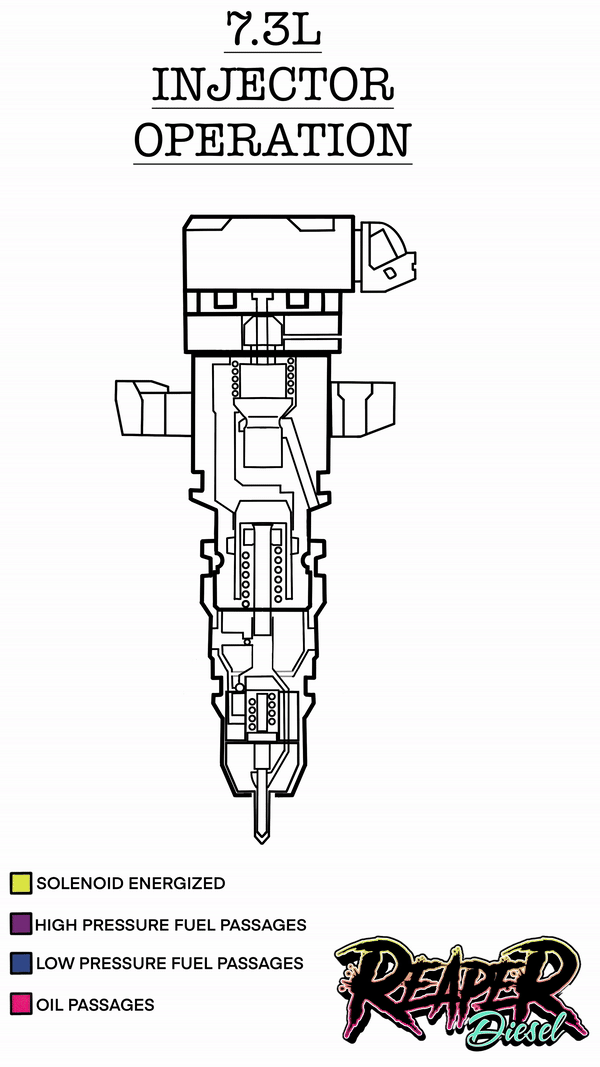7.3L Powerstroke HEUI Operation
- Andrew Whited

- Jan 1, 2024
- 4 min read
Updated: Jan 5, 2024
In the realm of diesel engines, the Hydraulically-actuated Electronically-controlled Unit Injector (HEUI) system was a noteworthy technological advancement. Developed in the 1990s by Caterpillar, this system was commonly utilized in a variety of diesel engines, especially those found in heavy machinery and trucks. In 1994, Ford introduced its first Direct-Injected, Turbocharged diesel engine utilizing this new HEUI technology in its 7.3L Powerstroke. The 7.3L Powerstroke HEUI system combines hydraulic mechanics with electronic precision, providing a distinct advantage to fuel injection that improves engine performance and efficiency over the Indirect-Injection systems it was replacing.
In-Depth 7.3L Powerstroke HEUI Operation
A HEUI (Hydraulically Activated Electronically Controlled Unit Injector) injector operates uniquely compared to common rail injection systems. The 7.3L Powerstroke HEUI system combines hydraulic power and electronic control to have more precise control on how the fuel is injected into the engine. By having more precise control the engine power produced by the 7.3L Powerstroke was increased, emissions were controlled better, and overall drivability was improved. Understanding 7.3L Powerstroke HEUI Operation is crucial to proper maintenance.
Here's a detailed explanation of how the 7.3L Powerstroke HEUI system works:
Activation by Electronic Solenoid: The process begins when the electronic solenoid in the injector gets energized by the Injector Drive Module (IDM). This action pulls a valve (poppet valve in 7.3L engines, spool valve in 6.0L engines) off its seat, closing the oil drain pathway and opening the inlet for high-pressure oil. The IDM is just a “dummy device,” it only does what is commanded of it by the PCM. The PCM determines when to open the Injector, and how long to keep it open (Pulse Width) based on several parameters such as the current RPM, Torque Demand by the Driver, and Mass Fuel Desired.

Pressure Transfer: The High-pressure oil transfers its pressure through the valve onto the intensifier piston. This piston has a significantly larger surface area compared to the plunger (fuel side), amplifying the pressure. The Intensifier Piston to Plunger ratio is 7:1, meaning that the Plunger is 7 time smaller, therefore the pressure on the Intensifier Piston will be multiplied by 7. For instance, 3,000 psi of oil pressure can translate to 21,000 psi of fuel injection pressure.

Fuel Injection: The high-pressure oil on top of the intensifier piston forces the plunger down, which in turn pressurized the fuel. Once the fuel overcomes the “crack” pressure ( the amount of force required to overcome the spring pressure) of the nozzle spring, the pressure lifts the nozzle needle and allows fuel to enter the combustion chamber. Crack Pressure can be assumed to be Minimum ICP to start the engine x 7, (500x7) which is 3500 psi. Anything lower than that, in combination with other issues such as the glow plugs not working, low ICP, or slow cranking speeds, could then cause fuel to be injected into the cylinder in sub optimal cylinder pressures and temperatures, therefore not igniting the fuel. If enough fuel enters the chamber without igniting, the affected cylinder could hydrolock.

End of Injection Cycle: After the solenoid is turned off, the Poppet Valve will return to the closed position, cutting off the high pressure oil supply. The fuel pressure in the nozzle will quickly drop below the crack pressure of the nozzle spring, which will then close the needle, stopping fuel injection. At the same time, the Intensifier Spring will return the Intensifier Piston back to the closed position and push out the excess oil back out of the poppet valve through the discharge port.
Refill Period: After all of the internal components have returned back to the closed position, fuel will refill the barrel, ready for the next injection cycle to begin. This is why proper fuel pressure is important. Without proper fuel pressure the injectors will not refill in time for the next injection cycle which can cause several drivability issues. In addition, If the engine continues to operate with low fuel pressure, the injectors can and most likely will fail. The fuel acts a lubricant for all of the internal components, and also acts as a “cushion”. Without proper lubrication, the internal components can begin to directly contact each other, and the metal on metal contact will rapidly accelerate wear on these parts. The metal can also cause the injectors to stick open, which will destroy your engine. Without the “cushion” effect the fuel provides, several of the internal components can begin to contact each other with a force equal to or greater than the crack pressure of 3500 psi, causing these parts to fail catastrophically. Furthermore, low pressure can cause the fuel to be aerated. Air is not a lubricant. This will also cause rapid internal wear. The expected injector life will drop off of a cliff in any of these circumstances.
The Hydraulically-actuated Electronically-controlled Unit Injector (HEUI) system that Ford began to use in 1994 in their 7.3L Powerstroke was a significant advancement in diesel engines, combining hydraulic mechanics with electronic control to improve fuel injection precision, engine performance, efficiency, and emissions control. The working mechanism involves electronic solenoid activation by the IDM as commanded by the ECM, pressure transfer from the oil to the Intensifier system, the fuel getting pressurized high enough to over come the nozzle spring pressure causing fuel to be injected, end of injection cycle which is essentially the reverse of everything up to this point, and then the refill period before the start of the next injection cycle.
Looking to breathe new life into your 7.3L Powerstroke? Check out these injectors:







Comments